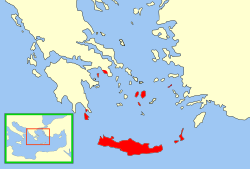Emirate of Crete | |||||||||
|---|---|---|---|---|---|---|---|---|---|
| 824/827–961 | |||||||||
 Emirate of Crete c. 900 | |||||||||
| Status | De facto independent, nominally under suzerainty of the Abbasid Caliphate | ||||||||
| Capital | Chandax | ||||||||
| Common languages | Arabic, Greek | ||||||||
| Religion | Sunni Islam, Chalcedonian Orthodoxy | ||||||||
| Government | Monarchy | ||||||||
| Emir | |||||||||
• 820s – c. 855 | Abu Hafs Umar I (first) | ||||||||
• 949–961 | Abd al-Aziz ibn Shu'ayb (last) | ||||||||
| Historical era | Middle Ages | ||||||||
• Andalusian exiles land on the island | 824/827 | ||||||||
• Byzantine reconquest | 961 | ||||||||
| Currency | Gold dinar, dirham | ||||||||
| |||||||||
| Today part of | Greece | ||||||||
The Emirate of Crete (Arabic: إقريطش, romanized: Iqrīṭish or إقريطية, Iqrīṭiya;[1] Greek: Κρήτη, romanized: Krētē) was an Islamic state that existed on the Mediterranean island of Crete from the late 820s to the reconquest of the island by the Byzantine Empire in 961. Although the emirate recognized the suzerainty of the Abbasid Caliphate and maintained close ties with Tulunid Egypt, it was de facto independent.
A group of Andalusian exiles led by Abu Hafs Umar al-Iqritishi conquered Crete in either 824 or 827/828, and established an independent Islamic state. The Byzantines launched a campaign that took most of the island back in 842-43 under Theoktistos, but the reconquest was not completed and would soon be reversed. Later attempts by the Byzantine Empire to recover the island failed, and for the approximately 135 years of its existence, the emirate was one of the major foes of Byzantium. Crete commanded the sea lanes of the Eastern Mediterranean and functioned as a forward base and haven for Muslim corsair fleets that ravaged the Byzantine-controlled shores of the Aegean Sea. The emirate's internal history is less well known, but all accounts point to considerable prosperity deriving not only from piracy but also from extensive trade and agriculture. The emirate was brought to an end by Nikephoros Phokas, who successfully campaigned against it in 960–961, re-annexing the island to the Byzantine Empire.
- ^ Canard 1971, p. 1082.